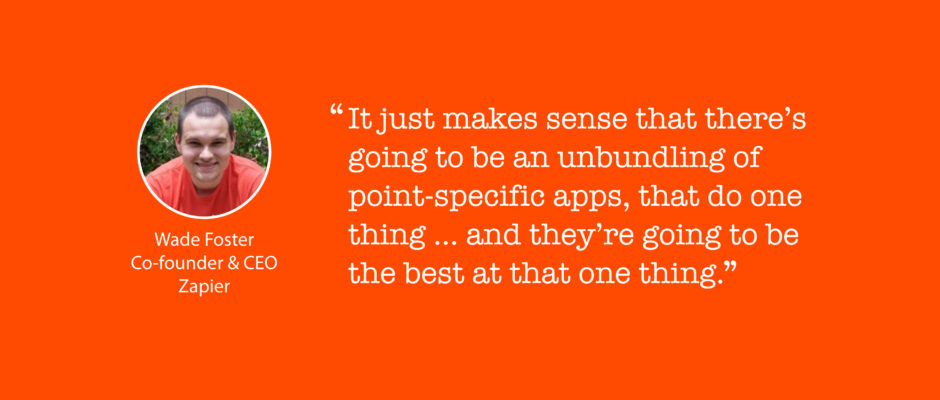In many ways, the success of Zapier is an indication of the times. The company and product seem to reflect all the trends in the SaaS industry today, even though the company started back in 2011. Ed Shelley spoke with co-founder and CEO, Wade Foster, about not only the growth of Zapier, but also their foresight and current perspective on API SaaS.
Ed: Wade, thanks so much for joining me.
Wade: Thanks for having me! I’m excited.
 Ed: I have such a huge list of questions that I’ve put together. Which probably reflects my enthusiasm for Zapier not just as a company and product, but I think you guys fit so well in certain trends in the SaaS industry today. Some of which we write about on a regular basis at ChartMogul. So it’d be great to get your input on some of that, too.
Ed: I have such a huge list of questions that I’ve put together. Which probably reflects my enthusiasm for Zapier not just as a company and product, but I think you guys fit so well in certain trends in the SaaS industry today. Some of which we write about on a regular basis at ChartMogul. So it’d be great to get your input on some of that, too.
We should start at the beginning. When people ask what Zapier is and what you do, what do you say?
Wade: Zapier is a workflow automation app. It hooks into about 800 of the most popular SaaS web apps that you might use to get work done. You can set up automations between things like Salesforce, Google apps, Slack, Dropbox, ChartMogul, you name it.
Ed: What’s the most common example you use to describe what Zapier can do?
Wade: A simple thing I do is that every time I get an email in Gmail that has an attachment, save the attachment to Dropbox. But you can also get a lot more creative in the things you can do. You can chain events across multiple apps and build really complex workflows. So your limitation is really your creativity.
You can also check out this interview on the SaaS Open Mic Podcast:
https://soundcloud.com/chartmogul/zapier-ceo-wade-foster
The origins of Zapier
Identifying a need
Ed: If I’m right (correct me if I’m not), it seems you guys were founded in 2011. You’ve been through Y Combinator. You obviously raised money that way but are now a self-sufficient, profitable business. Is that right?
Wade: Yep, you got it!
Ed: Awesome! So in 2011, things looked a bit different in the SaaS space. And obviously, you guys must have had quite a bit of foresight to see this trend in apps that have a growing need to communicate with each other, especially in SaaS. and to fill that need with this automation tool. How did things look back then? And why did you decide to jump on building Zapier?
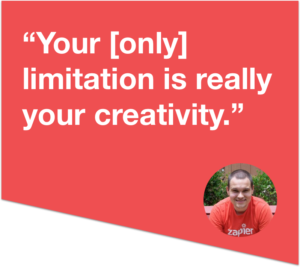 Wade: So, we were freelancing back then, and we’d get approached now and again to build these one-off integrations. Like, get PayPal payments into Quickbooks, take a list of leads and push it into Salesforce, that sort of thing. My founder Ryan pitched me over instant message saying “Hey! I think we could build something that automates this stuff for folks.” And the timing was right. APIs were starting to come into their own. Stripe was just starting to get some very early momentum. Twilio was pretty hot back then. So these APIs were getting more love than they had gotten in the past.
Wade: So, we were freelancing back then, and we’d get approached now and again to build these one-off integrations. Like, get PayPal payments into Quickbooks, take a list of leads and push it into Salesforce, that sort of thing. My founder Ryan pitched me over instant message saying “Hey! I think we could build something that automates this stuff for folks.” And the timing was right. APIs were starting to come into their own. Stripe was just starting to get some very early momentum. Twilio was pretty hot back then. So these APIs were getting more love than they had gotten in the past.
Ed: Fast forwarding to 2017, of course things have just increased in that same trend. We have businesses now that are purely API-based, so we’re talking API-first rather than products which support a programmatic interface. Was this something that you saw happening, or did you just act on a need you saw at the time?
Wade: I guess it makes sense, you know. We’d seen Twilio, we’d seen Stripe. We’d seen the transaction email providers, like MailGun. It made sense that APIs would become more of a thing. Where you’d see companies like Lob, where you could do an API call to send a postcard. Or Checker, where you could do an API call to do a background check. So, you know, an API call does just this bit of functionality, and a company has abstracted all the messy work that goes into doing that stuff, behind the scenes for you. So it makes sense that lots of these things you might do in a business, that are just bits of functionality, would get abstracted into an API call.
Overcoming business challenges
Ed: Zapier is a product that is effectively a glue that holds all of these services together. And without a lot of these other platforms and partners that you have, the product isn’t really much in itself. It doesn’t work without all of these integrations that you’ve built.
What are the challenges in building a business that relies so much on other platforms and services?
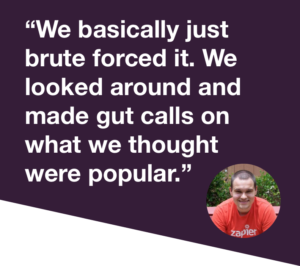 Wade: Well the big one is that you don’t have full control over what happens, right? We have 800+ partners. We can influence them, and make suggestions and recommendations, and our ability to influence over time has grown… But at the end of the day, every single one of our partners —they set their own product roadmaps, they have their own business models, and they set their own timelines for when things ship. So we have to work with them on that. We might think something is the greatest thing in the world, and we might say, “Hey you guys should really do this. We think this will change how business operates” … And if they don’t buy into that, it probably won’t happen.
Wade: Well the big one is that you don’t have full control over what happens, right? We have 800+ partners. We can influence them, and make suggestions and recommendations, and our ability to influence over time has grown… But at the end of the day, every single one of our partners —they set their own product roadmaps, they have their own business models, and they set their own timelines for when things ship. So we have to work with them on that. We might think something is the greatest thing in the world, and we might say, “Hey you guys should really do this. We think this will change how business operates” … And if they don’t buy into that, it probably won’t happen.
So that’s a challenge. Of course, we have to deal with quality issues where API versions change and quality might degrade. So we have a bunch of alerting and monitoring in place to ensure that the quality of what you’re doing on Zapier stays super high.
Early evolutions of Zapier, the business and the product
Ed: You mentioned you have now 800 integrations. Back in the early days, I guess it was much harder to kickstart your growth, given you needed some integrations and a certain volume to convince people of the value of the service. I’m curious how you managed to do that in the beginning when you were starting from nothing.
Wade: We basically just brute forced it. We looked around and made gut calls on what we thought were popular, so — “Hey, MailChimp is popular, let’s build an integration to MailChimp. Zendesk is popular, let’s build an integration to Zendesk. PayPal, let’s see if we can get PayPal on Zapier.”
So we just went out and looked for the API docs. If the API docs were easy enough to work with, the app was popular, we just built it. And we started to set up a framework of how to build these so that it was a little more plug and play for us. So it was fast. We got to where we could build integrations in — well, now the docs are good and clean — we can build an integration in 15 minutes.
Ed: Wow, okay. Did you see a tipping point where, at a certain size, people were more coming to you to propose partnerships?
Wade: Yeah. When we had around 50 apps on Zapier, we started to get a lot more inbound interest, people wanting apps on Zapier. People would email us saying, “Why isn’t our app on Zapier?” or “Why isn’t this popular app on Zapier?”
The answer was that we’re three guys brute forcing this. We can only build so many so fast. With that being the answer, we thought: How can we make this self-serve? How can empower others to build on Zapier?
So in 2012, as we were going through Y combinator, the big thing we released that summer was our developer platform. Which allowed people to build the integrations into Zapier.
Ed: One thing that’s really interesting to me as a marketing professional is approaching Zapier from a marketing perspective. I believe your background is in marketing too, right?
It’s having a product that’s not inherently visual, and the challenge of marketing the value of Zapier when it’s very difficult to show that value, especially on a landing page or your website. It seems like it’s very example driven, and you have to convey the value through specific examples.
 Wade: You’re absolutely right.
Wade: You’re absolutely right.
The thing we realized early on was that people wanted specific integrations. MailChimp had the integration directory, Salesforce had the app exchange, Quickbooks had apps.com. People were already looking in all these places for integrations, so we didn’t need to necessarily convince our earliest users to use an integration. They were already seeking that out. We basically just had to say, “Hey, we’ve got one!”
We were the only person in town, more or less, that would offer that. For us it was like: Let’s target people who are looking for certain integrations and make sure they can find us.
We didn’t have to say — “here’s what it looks like, these are the benefits, here’s all the features,” and that sort of thing. Instead, people just kind of knew.
Ed: Okay, so I’m guessing the biggest way people find Zapier is through these existing integrations and app stores and marketplaces and things.
Wade: Yes, that’s definitely a big way. Also just search, going into Google and searching if this thing exists. And now word of mouth is pretty big as well.
Ed: Is there anything that has changed from your original vision for Zapier?
Wade: Honestly, not too much. From the very get go, we wanted to build an integration hub, we wanted to build a way for people to connect apps. One big change was, about a year ago, we launched multi-step zaps so you could chain actions along. So that was a big improvement to the product that allowed people to do a lot of things you couldn’t do before. But that was more of an evolution and less of a “We didn’t expect this to happen” sort of thing.
How Zapier thinks about pricing
Why they added a freemium plan
Ed: Another thing I wanted to talk about was pricing. It’s a huge topic and a lot of people in SaaS struggle, esp in the early days, to find a pricing model for their product. For a product that’s so focused around integrations and is an infrastructure product, I want to know why you guys decided to go with a Freemium model, and whether you think that was critical to your growth.
Wade: So, we started not as freemium. For the first six months, we had a paid subscription model, with a free trial. And we did that because we had no money. We were a bootstrapped business; we had to make money. So we started that way.
 After YC, we decided to revisit it because we were able to get a little bit of money in the bank, and we thought maybe freemium is something that could work for us. And the big reasons we decided to try was 1) we realized the market of people who could use Zapier was massive, it was enormous. So we didn’t need everyone to pay us to make a really good business out of it. And 2) freemium really allowed people to get in and play with the product, and to figure out what they wanted to use it for. Because Zapier isn’t always a thing you can figure out right away, the very first thing. Sometimes you have to figure out: What’s the use case I want? How do I set this up? You have to plug in these other pieces. So while it’s easy to do that stuff, sometimes it needs that creative spark before you get started. And freemium allowed people to do that.
After YC, we decided to revisit it because we were able to get a little bit of money in the bank, and we thought maybe freemium is something that could work for us. And the big reasons we decided to try was 1) we realized the market of people who could use Zapier was massive, it was enormous. So we didn’t need everyone to pay us to make a really good business out of it. And 2) freemium really allowed people to get in and play with the product, and to figure out what they wanted to use it for. Because Zapier isn’t always a thing you can figure out right away, the very first thing. Sometimes you have to figure out: What’s the use case I want? How do I set this up? You have to plug in these other pieces. So while it’s easy to do that stuff, sometimes it needs that creative spark before you get started. And freemium allowed people to do that.
Another thing freemium helped us with was our partnerships. It really helped to have that generous free plan to get partners to say, “Yeah I’m cool pointing my customers to Zapier because I know people can try it for free, and it’s easy to get started.” So it really made it easy for other partners to refer people to Zapier.
Perceived value vs. actual value
Ed: I think the other thing there, I can probably contribute here from a customer perspective, is that when you get that realization of value —when you’ve plugged things together and you’ve set up a flow that makes sense for you — the value becomes clear so quickly and so strongly, that it’s almost a no-brainer to fit that into your work process. And once you’ve done that, it’s such a sticky product that you almost can’t go back. You’ve added so much efficiency or saved so much time or simply achieved something you wouldn’t be able to achieve without the tool, that it’s just a no-brainer to become a paying customer at that point.
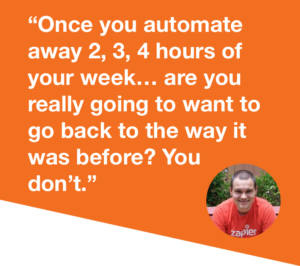 Wade: Yes, like you said, once you automate away 2, 3, 4 hours of your week… are you really going to want to go back to the way it was before? You don’t.
Wade: Yes, like you said, once you automate away 2, 3, 4 hours of your week… are you really going to want to go back to the way it was before? You don’t.
Another interesting thing that I think exists here, which I didn’t realize going in, but I saw a study done by IKEA where folks that bought things from IKEA and then built them — the act of going through and assembling IKEA furniture makes people value it much higher when they try to resell it. They try to sell it at a much higher rate than is reasonable. And the reason they say that is because folks went through the emotional attachment of building that thing.
And Zapier has a bit of that, too. You make this little cool thing and at the end, you get it, and it’s like, “It works! This is awesome!” So you have an affinity towards it as well.
Ed: That’s true. I can identify with that. We’ve built a pretty solid marketing flow for handling a lead pipeline, and it’s something that we’ve designed and created. It’s our thing. And we obviously optimize that over time and it’s still flexible and we can tweak it, but the sense of creation there is really strong.
Trends in SaaS and where Zapier fits
Why SaaS is not consolidating
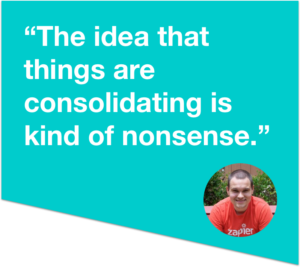 Ed: So I think a lot of the success of Zapier today at least is because we’ve seen a lot of this unbundling of SaaS products into very small, narrow solutions that solve one small problem. And obviously, we need all these different services to talk to each other if we want an efficient work process. If you look at a marketer’s software stack, actually it’s kind of insane. The number of different tools we use is way more than it would have been 10 years ago.
Ed: So I think a lot of the success of Zapier today at least is because we’ve seen a lot of this unbundling of SaaS products into very small, narrow solutions that solve one small problem. And obviously, we need all these different services to talk to each other if we want an efficient work process. If you look at a marketer’s software stack, actually it’s kind of insane. The number of different tools we use is way more than it would have been 10 years ago.
How do you see this trend in the industry? A lot of people talk about the unbundling of SaaS, but it also seems there’s this cycle where things eventually consolidate again into big, single solutions. Is that something that you would agree with, or what do you think about that?
Wade: The idea that things are consolidating is kind of nonsense. Yeah, in one or two situations there is some consolidation. But on the whole, it’s so easy to build an app nowadays! The tooling is so good that a single developer can build a small bit of functionality that solves a very specific, niche problem so quickly and so much better than a massive conglomerate of apps can. It just makes sense that there’s going to be this unbundling of point-specific apps, that do one thing, one thing really well, and they’re going to be the best at that one thing! I mean we mentioned the API-ification of all these things, and that’s part of it.
Enterprise software is a different ball game where the bundling does make sense to a degree, and I understand why they’re looking for it. But for small or mid-market business, they don’t want these massive tools. They want one thing. “I just want to send an email to a customer. I just need to be able to text him when this happens.” They don’t want to add a lot of complexity to their life. They just want that one thing that allows them to get their message across to customers, or something like that.
Ed: And I guess a selection of well-targeted small solutions is always going to be better than a large suite of applications, probably 70% of which are not designed for that person’s specific problem.
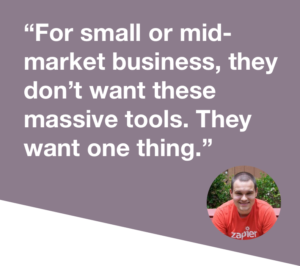 Wade: Yeah! Exactly. That’s the challenge as you start to get bigger and you start to add multiple product lines. When you have multiple product lines, it’s like — well, which one is the most important? One is going to get more love than another one. So the other apps are kind of half baked compared to the main, principal app. And maybe they’re feature bloated.
Wade: Yeah! Exactly. That’s the challenge as you start to get bigger and you start to add multiple product lines. When you have multiple product lines, it’s like — well, which one is the most important? One is going to get more love than another one. So the other apps are kind of half baked compared to the main, principal app. And maybe they’re feature bloated.
So when you sign up for these [as a user], it’s like — well, which pieces of this do I want to use? And because there’s so much other stuff going on, it can actually be harder to get started using it.
The impact of integrations and accessibility
Ed: We’re building all these services today that are built using APIs to communicate with each other and to integrate with different services. Do you have a vision for what the extension of this is? To me, there are still a lot of problems around integrating APIs. It’s still a highly technical job to do that. Is there some v2 of this where everything just talks to each other without the need for that?
Wade: Well I think Zapier is a big part of the solution for some of this stuff. We have people now who are not engineers, but they’re using stuff like Twilio or Sendgrid and Stripe to deliver products to folks. Basic marketers who’ve never used an API call in their life are able to use tools like Zapier because they are easy to use. So it brings a level of accessibility to this functionality that you don’t get when you require the user to know what a CLI tool is or a coral request is.
Ed: I guess there’s another part to this as well which is that companies who are building products today can much more easily become platforms, through Zapier and through integrating with your [sales]. 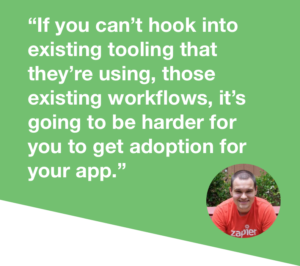 It’s almost expected today that any product has a whole suite of integrations to connect the other services that you use. In fact, it’s almost infeasible to launch a product without that, I might argue. It might be a separate case. Is that how you think about this?
It’s almost expected today that any product has a whole suite of integrations to connect the other services that you use. In fact, it’s almost infeasible to launch a product without that, I might argue. It might be a separate case. Is that how you think about this?
Wade: Yeah, it’s really tough when you’re building your new app, and it’s very point-specific and it does one thing really well. You really do need to hook into an array of apps that your end user is going to be using in the workplace. I think we’ve all seen studies of the average small business using about a dozen apps in their line of work already. And if you can’t hook into that existing tooling that they’re using, those existing workflows, it’s going to make it harder for you to get adoption for your app.
The SaaS metrics that power Zapier
Ed: Obviously at ChartMogul, we’re obsessed with metrics, specifically those around SaaS and subscription businesses. I’d love to know what you guys use at Zapier, what kind of metrics you use internally to measure the success of the product.
Wade: We’re looking at a handful of things on a weekly basis. Weekly sign up rate, to make sure we’re attracting new folks to the product. Activation rate, to make sure those people are becoming engaged with the product. We’re tracking our ability to drive expansion revenue, so to expand customers’ usage of the product, to go from using it for one thing to using it for five things. All the way down to eventually tracking the revenue growth that we’re generating, and how can we grow the business from there.
Ed: Would you call yourself a data-driven business? How much do you lean on the numbers and metrics?
Wade: I’d say we’re data-informed rather than data-driven. Not every decision has a number that goes with it. We definitely try to pull in and use data to help us make good decisions. But we’re also using a lot of qualitative data, from talking to customers, talking to partners… And we also feel that gut feel is a decent metric as well. We can consider ourselves experts because we’ve been in this a while now. Our guts are probably better than the average person at guessing on this stuff. So, in the absence of any data, I think that’s also a fair thing to do as well.
Ed: I totally agree. If you have one metric that was to be your compass metric, the one that you watch to measure your success on a high level, which one would that be?
Wade: New weekly active users.
Ed: New weekly active users. Okay, interesting! I guess that’s something you guys follow closely, week to week.
Wade: Yes, I’m looking at it every week.
Ed: Cool. What kind of decisions or actions does that metric inform?
Wade: Well, I think it informs two things, right? You’re looking at new weekly active users so it’s making sure that we’re driving new folks to the platform. 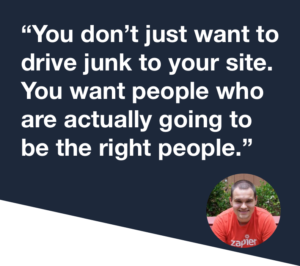 That’s a big part of it. You’re not going to grow that number if you aren’t driving traffic and converting those into signups. You care about the active part because you don’t just want to drive junk to your site. You want people who are actually going to be the right people. And you care that it’s growing. So you want to make sure that every week you want to raise the bar on that as well.
That’s a big part of it. You’re not going to grow that number if you aren’t driving traffic and converting those into signups. You care about the active part because you don’t just want to drive junk to your site. You want people who are actually going to be the right people. And you care that it’s growing. So you want to make sure that every week you want to raise the bar on that as well.
Ed: Yep. Almost every company has their own definition of success and their own custom metric to define it. So it’s really interesting to hear how different people see the success of their product, especially when it comes to engagement.
Distributed SaaS a.k.a. Working (and hiring) remotely
Ed: One last thing, which I have to ask because, again, it’s such a hot topic and you guys seem to have nailed so well the concept of a fully distributed, remote business. I guess the first question is: Why did you guys decide to build a completely remote company?
Wade: Well it was mostly out of necessity. When we started Zapier, we were in Columbia, MO and we had no money. It started as a side project; it was a nights and weekends things. Out the gate, we were just working on Zapier whenever we could and wherever we could. So we got good at working this way, we got good at working through pull requests or through Trello cards or through chat. It came pretty naturally for us.
And then after YC, when it came time to start hiring folks, we didn’t know anyone in the Bay Area because we’d only been there a few weeks, a couple months. The people that we did know were friends who happened to live elsewhere. So the first folks we hired were in Chicago and back in Missouri. So we started as a remote team and we just got good at it as we went along.
The tooling is good enough now that you can really make this work. There were enough example companies to look at and say, “Yeah, other folks are doing this successfully. We think we can do it, too.”
Ed: For those people who are starting a business today and are also considering going completely remote, what are the things you’d say are absolutely critical to get right?
Wade: Pay attention to how you’re documenting your work. Out the gate, try to work in public, if you have teammates. Set up Slack and talk in public channels. Document pull requests and things like that.
The toughest thing in remote is when knowledge is hidden, so try not to hide what you know.
Ed: And when it comes to artifacts such as meetings and get-togethers, what do you guys have in terms of a structure that keeps you on the right path?
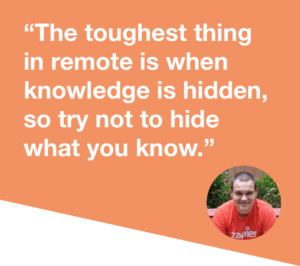 Wade: For meetings, they always have an agenda and generally someone always takes notes in a Google Doc, and they always get published somewhere. So outcomes and action items are available if someone needs to know what happened.
Wade: For meetings, they always have an agenda and generally someone always takes notes in a Google Doc, and they always get published somewhere. So outcomes and action items are available if someone needs to know what happened.
Ed: Do you think hiring is more difficult when you’re 100% remote?
Wade: I actually think it’s easier. You’re not limited to the people within a 30-mile radius. So you’re able to hire from people across the world. Stack Overflow also just did a study that showed, I think, for 50% of people looking for jobs right now, working remotely is top-of-mind for them. That’s a huge portion of the market that cares about remote. So, I think it really does increase your visibility and access to candidates, which is great.
Looking ahead
Ed: Cool. What does 2017 hold for you guys? I’m sure you have big plans. What does the future of Zapier look like?
Wade: Yeah! Good question. We actually just launched this past week a new version of our developer platform, that lets you build apps via a command line. It should make it a lot easier for folks who are building SaaS apps and have APIs to plug their apps into Zapier and make it easier for them to maintain.
We’re also starting work on a team product. So it should make it easier to collaborate and work on your zaps as part of a group, in an organization.
Ed: Sounds amazing! Wade, this has been really cool. Thanks for answering these questions. Where can people find out more? I’m assuming that you’re always hiring, so perhaps if you are, feel free to plug that.
Wade: Yeah! Zapier.com — and you can check out our jobs page, zapier.com/jobs. We are hiring a lot right now, so smart folks who are interested, definitely check that out. And if you have any questions for me, I’m hanging out on Twitter @wadefoster, and wade@zapier.com is my email address. So, I’m happy to help.
